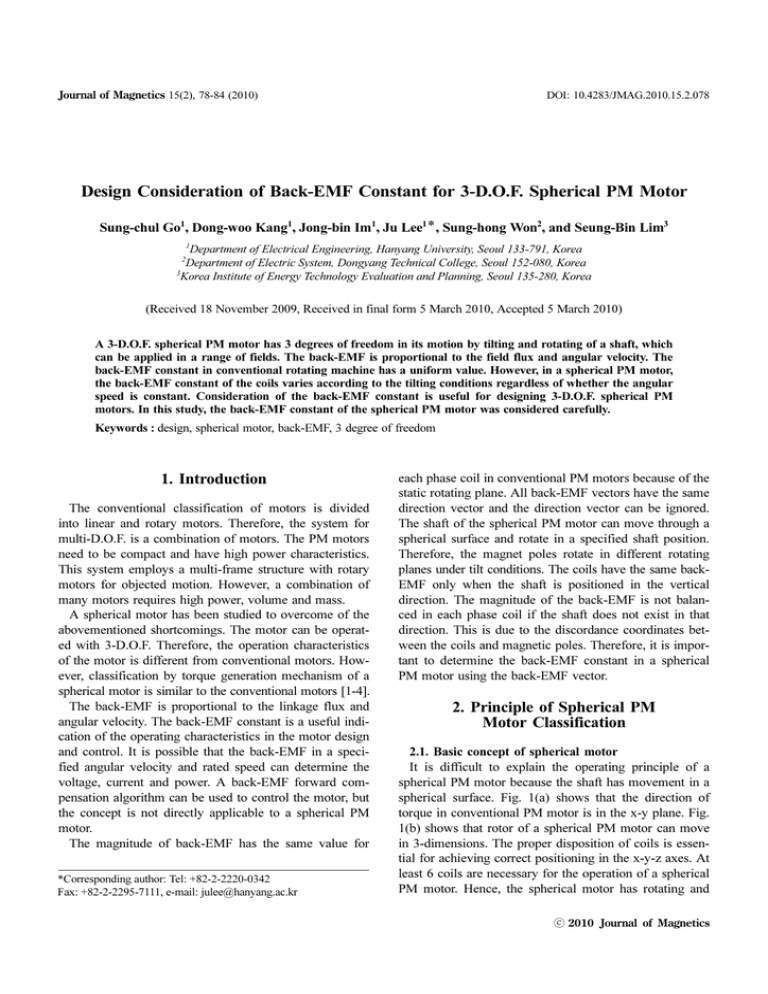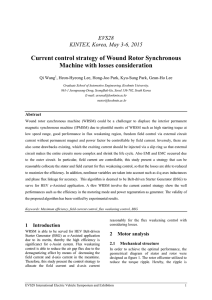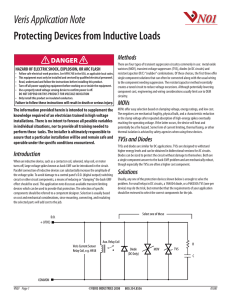
Journal of Magnetics 15(2), 78-84 (2010)
DOI: 10.4283/JMAG.2010.15.2.078
Design Consideration of Back-EMF Constant for 3-D.O.F. Spherical PM Motor
Sung-chul Go1, Dong-woo Kang1, Jong-bin Im1, Ju Lee1*, Sung-hong Won2, and Seung-Bin Lim3
1
Department of Electrical Engineering, Hanyang University, Seoul 133-791, Korea
Department of Electric System, Dongyang Technical College, Seoul 152-080, Korea
3
Korea Institute of Energy Technology Evaluation and Planning, Seoul 135-280, Korea
2
(Received 18 November 2009, Received in final form 5 March 2010, Accepted 5 March 2010)
A 3-D.O.F. spherical PM motor has 3 degrees of freedom in its motion by tilting and rotating of a shaft, which
can be applied in a range of fields. The back-EMF is proportional to the field flux and angular velocity. The
back-EMF constant in conventional rotating machine has a uniform value. However, in a spherical PM motor,
the back-EMF constant of the coils varies according to the tilting conditions regardless of whether the angular
speed is constant. Consideration of the back-EMF constant is useful for designing 3-D.O.F. spherical PM
motors. In this study, the back-EMF constant of the spherical PM motor was considered carefully.
Keywords : design, spherical motor, back-EMF, 3 degree of freedom
1. Introduction
The conventional classification of motors is divided
into linear and rotary motors. Therefore, the system for
multi-D.O.F. is a combination of motors. The PM motors
need to be compact and have high power characteristics.
This system employs a multi-frame structure with rotary
motors for objected motion. However, a combination of
many motors requires high power, volume and mass.
A spherical motor has been studied to overcome of the
abovementioned shortcomings. The motor can be operated with 3-D.O.F. Therefore, the operation characteristics
of the motor is different from conventional motors. However, classification by torque generation mechanism of a
spherical motor is similar to the conventional motors [1-4].
The back-EMF is proportional to the linkage flux and
angular velocity. The back-EMF constant is a useful indication of the operating characteristics in the motor design
and control. It is possible that the back-EMF in a specified angular velocity and rated speed can determine the
voltage, current and power. A back-EMF forward compensation algorithm can be used to control the motor, but
the concept is not directly applicable to a spherical PM
motor.
The magnitude of back-EMF has the same value for
*Corresponding author: Tel: +82-2-2220-0342
Fax: +82-2-2295-7111, e-mail: julee@hanyang.ac.kr
each phase coil in conventional PM motors because of the
static rotating plane. All back-EMF vectors have the same
direction vector and the direction vector can be ignored.
The shaft of the spherical PM motor can move through a
spherical surface and rotate in a specified shaft position.
Therefore, the magnet poles rotate in different rotating
planes under tilt conditions. The coils have the same backEMF only when the shaft is positioned in the vertical
direction. The magnitude of the back-EMF is not balanced in each phase coil if the shaft does not exist in that
direction. This is due to the discordance coordinates between the coils and magnetic poles. Therefore, it is important to determine the back-EMF constant in a spherical
PM motor using the back-EMF vector.
2. Principle of Spherical PM
Motor Classification
2.1. Basic concept of spherical motor
It is difficult to explain the operating principle of a
spherical PM motor because the shaft has movement in a
spherical surface. Fig. 1(a) shows that the direction of
torque in conventional PM motor is in the x-y plane. Fig.
1(b) shows that rotor of a spherical PM motor can move
in 3-dimensions. The proper disposition of coils is essential for achieving correct positioning in the x-y-z axes. At
least 6 coils are necessary for the operation of a spherical
PM motor. Hence, the spherical motor has rotating and
ⓒ 2010 Journal of Magnetics
Journal of Magnetics, Vol. 15, No. 2, June 2010
Fig. 1. Movement region of the rotor in conventional and
spherical PM motors.
− 79 −
Fig. 4. Relationship between the shaft and stator plane of the
spherical PM motor.
tilting characteristics.
2.2. Structure Basic concept of spherical motor
Two poles and 6 coils are needed to satisfy the
spherical operation. Fig. 2(a) shows a stator with 12 coils
in 2 layers. Fig. 2(b) shows a rotor composed 2 pole pairs.
In addition, the shaft can only move in the open surface
of the stator. Some frame structures are essential to sup-
Fig. 2. Structure of a spherical PM motor.
port rotor centering. Fig. 3 shows the precise composition
of the spherical PM motor. No change in shaft position
makes a stand-still of two frames. The shaft position is
defined by the angles of Φs, θs, and θr(ωt) in Fig. 4. In
this case, the shaft position is defined as angle Φs from
the z-axis first. The shaft position in the x-y plane is
defined by θs. The rotation of the shaft is defined by
θr(ωt). The parameter ω is the angular velocity. This
angle θr is related to the position of the magnet pole.
2.3. Coordination transformation
The position of the flux vector is the main element for
obtaining the back-EMF. The coils are in the stator and
the magnetic poles are in the rotor. A Z-Y-Z Euler transformation using Z-Y-Z Euler angles is a useful relative
transformation [5]. The Z-Y-Z Euler transformation is
shown in equation (1). Fig. 5 shows the α, β, γ rotation
angles used in equation (1). The Z-Y-Z Euler transformation is a relative transformation. The vector position
can be determined in different axes frames.
cos ( α )cos ( β )cos ( γ )−sin ( α )sin( γ )
[ Γ ]= sin( α )cos ( β )cos ( γ ) + cos ( α )sin( γ )
−sin ( β )cos ( γ )
Fig. 3. Composition of a 4 pole spherical PM motor.
Fig. 5. Transformation by the Z-Y-Z transfer function.
− 80 −
Design Consideration of Back-EMF Constant for 3-D.O.F. Spherical PM Motor − Sung-chul Go et al.
−cos ( α )cos ( β )sin ( γ )−sin ( α )sin ( γ ) cos ( α )sin ( β )
−sin( α )cos ( β )sin ( γ )+cos ( α )cos ( γ ) sin ( α )sin ( β )
sin( β )sin( γ )
cos ( β )
(1)
s
The magnitudes of the back-EMF in stator coils are the
affected position of the shaft in a spherical PM motor.
Therefore, the concept of the back-EMF constant is
necessary in a spherical PM motor. The back-EMF vector
calculation is necessary for the back-EMF constant. The
back-EMF is related to the linkage flux and velocity.
Accordingly, the position vector of the coils, the vector of
the airgap magnetic density, and the line velocity in the
coils are essential for calculating the back-EMF vector.
3.1. Definition of position vector of coils
The definition of the coil position is essential for
obtaining the linkage flux and line velocity in coils. The
spherical PM motor has a total of 12 coils. The spherical
coordinate is useful for defining the position vector of the
coils in the stator. Therefore, the vector is defined in
equation (2).
T
(2)
where Rs denotes the semi diameter between the diagonal
coils. It was assumed that m numbers of coils are dispatched with the δ c angle. The position vector of the j coil
is expressed in equation (3).
s
j
s =Rs [ sin( φ )cos ( ( j – 1 )δc ) sin( φ )cos( ( j – 1)δc ) cos ( φ ) ]
T
(3)
( j = 1, 2, …, m)
3.2. Definition of magnetic density vector
The magnetic density is related to the position of the
magnetic pole and rotor [6]. Therefore, the position vector
of the magnetic pole is important. It is assumed that n
numbers of magnetic poles are dispatched with a δm angle
around the shaft. The position vector of the k magnetic
poles rkr is expressed as equation (4).
r
rk=Rr[sin(φ )cos((k – 1)δm) sin(φ )cos((k – 1)δm) cos(φ )]
s
r
B k =B max r k =B max [ Γ ]r k
3. Back-EMF Vector
s=Rs [ sin( φ )cos ( θ ) sin( φ )sin( θ ) cos ( φ ) ]
The vector of the magnetic flux density for back-EMF
was calculated in the stator plane from rkr and the magnitude of the magnetic flux density using equation (6).
T
The linkage flux in the j coil is obtained by the inner
product of the magnetic flux density vector and position
vector of the coils (7).
s
Ψj =kφ
n
∑ Bsk ⋅ rsj
( j = 1, 2, …, m, kΦ is constant of linkage flux)
3.3. Definition of back-EMF Vector
The back-EMF vector was calculated by the outer product of the magnetic density vector and line velocity in
coils. The line velocity was obtained first, as shown in
Fig. 6. The unit direction vector of the rotor shaft is uA,
the position vector of the coil is uR, and the vector of the
line velocity is uv. The relationship can be expressed as
follows (8).
u A =u R × u v
(8)
Hence, uv is expressed as equation (9).
u R × u A =u R ( u v ⋅ u R )−u v ( u R ⋅ u R )= – u v
s
s
v j =ω ( u A × s j )
(5)
(10)
The back-EMF vector in the coils was calculated as
follows (11):
s
s
s
e j =Ψ j ( u R × v j )
(11)
Therefore, the back-EMF vector has a direction orthogonal to the direction of the position vector of the coils.
The direction of rotation is constant. In addition, the
upper coils and lower coils have the same direction of the
(4)
T
(9)
The unit vector of the line velocity of the j coil considers the angular velocity as follows (10): ( j = 1, 2, …, m)
The position vector of the magnetic poles rkr needs to
transform to the stator plane because the induced EMF is
calculated in the stator coils. Therefore, the position vector
of the magnetic poles is transformed to orthogonal coordinates by the Z-Y-Z Euler angles (5).
s
(7)
k=1
(k = 1, 2, …, n)
rk=[Γ]Rr[sin(φ )cos((k – 1)δm) sin(φ )cos((k – 1)δm) cos(φ )]
(6)
Fig. 6. Vector of the line velocity in a coil.
Journal of Magnetics, Vol. 15, No. 2, June 2010
− 81 −
z-axis component. However, the upper coils have a central x and y axis direction. On the other hand, the lower
coils are in the outer x and y axis direction of the backEMF vector because the back-EMF vectors are orthogonal to the position vector of the coils.
3.4. Consideration of back-EMF constant
In a conventional motor, the relationship between the
coils and poles are not changed in the steady state [7].
The back-EMF vector in the stator coils is affected by the
shaft position because of the magnetic pole. In a conventional rotating motor, each phase coils has the same direction of the back-EMF vector. Therefore, the direction has
been ignored. However, only the magnitude of the backEMF cannot represent the spherical motor characteristic.
The direction of the back-EMF vector is related to the
position vector of the coil and rotating direction.
In different shaft tilt conditions, the magnitude of the
back-EMF in each coil has a different value. Therefore,
the same speed condition does not mean the same backEMF measurement in each coil. Therefore, the back-EMF
vector must be considered carefully. The three direction
element of the back-EMF vector exists in the stator reference frame. In addition, the component in the shaft tilt
condition was varied. The back-EMF is produced by coils
and a magnet. The magnet direction affects the backEMF. In addition, the position of the magnet is fixed in
the rotor. Therefore, the back-EMF was considered in the
rotor reference frame. In this case, the z-axis of the rotor
is the direction of the shaft. In addition, the back-EMF
components of the x and y axes are almost zero due to the
back-EMF vector direction. Consequently, the component
of the z-axis is the effective back-EMF vector in the rotor
plane. The vector is transformed to the rotor reference
frame. The Z-Y-Z Euler angles are as follows (12):
change in shaft position. Therefore, this concept is considered appropriate in a spherical PM motor.
In a spherical PM motor, the back-EMF constant means
the maximum back-EMF in the range of all operations. In
the vertical shaft position, rotation produces a lower backEMF than that back-EMF calculated from the proposed
back-EMF constant. However, some coils have a maximum
back-EMF in the hard tilting operation condition.
4. Measurement of Back-EMF Constant
The back-EMF constant was verified by measuring the
back-EMF. The back-EMF measurement system is composed of a spherical PM motor, load motor, and PXI
instrument, as shown in Fig. 7. The PXI instrument is
operated using Labview language and a FPGA module
for data acquisition. Table 1 shows the specification of the
test bed. The 4 poles spherical PM motor has basically 12
coils in two layers. Therefore, each coil has a different
effect of magnet of rotor rotation. Therefore, it is impossible to consider all cases. Three cases were selected to
consider the back-EMF in different shaft positions. Fig. 8
shows the cases. The 12 coils were named with AU, BU,
CU, DU, EU, FU, AD, BD, CD, DD, ED, and FD in 60(º)
α = θs
β = φs
(12)
γ = θ r −θ s cosφ s
The element of the z-axis in the rotor reference frame is
expressed as (13).
m
s ⎛
s ⎞
e Z = ⎜ ∑ ( u A ⋅ [ Γ ] e j )⎟ u A
⎝j=1
⎠
(13)
The back-EMF constant was calculated by the backEMF in the rotor shaft axis over the angular velocity (14).
Table 1. Specification of the test bed.
Load motor
Torque transducer
Back-EMF
measurement
BLDC Motor (700W)+Controller
None
Test target
Spherical PM Motor
4 poles, 12 coils
Test points
Angular speed
Case I
Case II
Case III
132 [rpm]
no tilt
Tilt to negative x-axis
Tilt to negative y-axis
Test system
r
ez ⋅ uA
k = ------------ω
r
e
Fig. 7. Back-EMF measurement system of a spherical PM
motor.
(14)
In this case, the back-EMF constant is unaffected by the
NI PXI Instrument+Labview 8.5
− 82 −
Design Consideration of Back-EMF Constant for 3-D.O.F. Spherical PM Motor − Sung-chul Go et al.
Table 2. Magnitude of Back-EMF in upper coils (132[rpm]).
Case
AU Coil [V]
BU Coil [V]
CU Coil [V]
DU Coil [V]
EU Coil [V]
FU Coil [V]
Case I
Case II
Case III
0.4585
0.6041
0.4951
0.4323
0.5256
0.5584
0.4768
0.3650
0.5524
0.4503
0.2005
0.4829
0.3945
0.3349
0.2107
0.4441
0.5119
0.2111
Fig. 8. Determination of 3 cases for a back-EMF consideration.
intervals and 2 layers. The notation, AU, means the A
phase and upper coils. The notation, FD, means the F
phase and lower coils. The cases were determined to consider the various back-EMF magnitudes of 12 coils. Case
I is the no tilt condition of the shaft, Φs=0(º) θs=0(º).
Therefore, the magnet pole affects the same magnitude of
the back-EMF to each coil. The condition of case II was
tilted by the y-axis negative rotation in the rotor reference
frame Φs=18(º) θs=180(º). Hence, the magnet pole is
closest to the AU and DD coils, and magnitude of the
back-EMF is highest in those coils. Case III is the tilt to
the negative y-axis, Φs=18(º) θs=270(º). Therefore, the
magnet pole is closest to the middle point of the BU and
CU coils and the back-EMF magnitude reaches a peak in
the BU, CU, ED and FD coils.
The system receives an encoder signal and back-EMF
signal from a motor with interfacing. The configuration
for the measurement was divided into 3 cases. Fig. 9
shows the back-EMF waveform of 3 cases. Fig. 9(a) and
(b) presents the results of case I. Fig. 9(c) and (d) is
shows case II and Fig. 9(e) and (f) shows case III. Table 2
shows the effective value of the back-EMF in the upper
coils. The back-EMF was highest in the AU coil in the
case II measurement.
The back-EMF constant was obtained by the back-EMF
over speed. In addition, the constant did not change under
the linear magnetic saturation region in a conventional
motor. However, the back-EMF magnitudes of the coils
are different in cases II and III. Therefore, the back-EMF
was calculated in the in the rotor reference frame. In the
case I, the α and β Euler angles are both 0º. In the case II,
the α the β Euler angle is 18(º) and 180(º), respectively.
In the case III, the α and β Euler angle is 18(º) and
270(º), respectively. The γ Euler angle was determined by
the position angle between the magnet and each coil. The
back-EMF vector was calculated using equation (1) with
the angles. Table 3 lists the back-EMF constant in the
rotor x-y-z directions and the units are voltage per rad/s.
The Euler angles were determined by the shaft position.
The back-EMF constant of the z-axis was almost constant
in the three cases. The difference in the z-axis back-EMF
constant in Fig. 9 was considered to be measurement
error. The back-EMF constant in the rotor reference frame
was transferred from the value in the stator reference
frame by Euler’s transformation.
5. Conclusion
The magnitude of the back-EMF in a spherical PM
motor varies according to the shaft position. It is not
possible have a constant back-EMF in the rated speed of a
spherical PM motor due to shaft movement. The advance
of a spherical PM motor varies according to the operating
condition in same speed rotation. However, the maximum
back-EMF is important under the condition of rated
rotation. A proper back-EMF constant consideration is a
fixed back-EMF constant. In addition, the back-EMF is
determined by magnet poles rotating frame. In a conventional rotating motor, the direction of the back-EMF was
ignored because of the same direction. However, in a
Journal of Magnetics, Vol. 15, No. 2, June 2010
− 83 −
Fig. 9. Back-EMF waveform in three cases.
Table 3. Back-EMF constant in rotor reference frame.
Case
Case I
Case II
Case III
Euler angles (Degree)
Back-EMF constant (V/(rad/s))
In rotor reference frame
α
β
X-axis
Y-axis
Z-axis
0
180
270
0
18
18
0.0000
0.0042
0.0000
0.0000
0.0008
0.0037
0.0154
0.0147
0.0148
spherical PM motor, the direction of the back-EMF in
each coil must be considered. The shaft direction varies
according to the operation. The back-EMF is affected by
the shaft position. In this case, the spherical PM motor
designer must consider the limitation of the maximum
operation. Therefore, the back-EMF vector can be used to
indicate the motor design characteristics. The back-EMF
− 84 −
Design Consideration of Back-EMF Constant for 3-D.O.F. Spherical PM Motor − Sung-chul Go et al.
constant is affected by the shaft position. This consideration was verified by measuring the back-EMF in the
three cases of the shaft position. Overall the back-EMF
constant in a spherical PM motor is useful for designing
and controlling the motor.
Acknowledgment
This study was supported by the National Research
Laboratory (NRL) through a grant provided by the Ministry of Education, Science & Technology (MEST, contract
number R0A-2008-000-20048-0), and partially by the Manpower Development Program for Energy & Resources
supported by the Ministry of Knowledge and Economy
(MKE), Republic of Korea.
References
[1] F. Williams, E. Laithwaite, and J. F. Eastham, Proc. Inst.
Elec. Eng. 106A, 471 (1959).
[2] T. Yano, T. Suzuki, M. Sonoda, and M. Kaneko, Proc.
1999 IEEE/RSJ Int. Conf. Intelligent Robots and Systems,
1393 (1999).
[3] B. B. Bederson, R. S. Wallace, and E. L. Schwartz, Proc.
1993 IEE Int. Conf. Robotics and Automation, Vol. 2, 630
(1993).
[4] S. Toyama, S. Hatae, and M. Nonaka, Int. Conf. Advanced
Robotics 1, 55 (1991).
[5] John J. Craig, Introduction to Robotics, Pearson Prentice
Hall, Englewood Cliffs (2005).
[6] Changliang Xia, Hongfeng Li, and Tingna Shi, IEEE
Trans. Magn. 44, 2016 (2008).
[7] Jhih-Da Hsu, and Ying-Yu Tzou, IEEE Power Electronics
Specialists Conf., 939 (2007).





